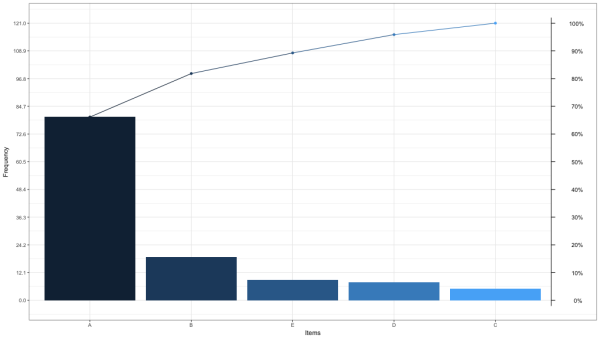Pareto Principle states that roughly 20% of actions produce 80% of results, or 80% of effects come from 20% of causes. This is one of the most useful principles for finding the most important things to focus on. Identifying the 20% of your efforts that have the biggest impacts is a fundamental step in maximising your efficiency.
Historical context
Italian Economist and Sociologist Vilfredo Pareto (1848-1923) observed that 80% of the land in Italy was owned by 20% of the population. While investigating other countries he found the same unequal distribution of income and wealth in each. Pareto published his observations and mathematical formulas that described his findings[1]. After publication, researchers in other areas of science and business began to find the same unequal distribution in their fields.

Pareto Chart
Vital few, trivial many
In the late 1940s, business thinker, Joseph M. Juran described what he called the vital few and trivial many, attributing the concept to Pareto’s findings[2]. Thus, Pareto’s Principle became the name of one of the most significant of universal principles.
The Pareto Principle highlights a common approach for consultants: focus on solving a problem where you can produce the highest positive impact with the lowest amount of effort because consultants usually have very limited time to work on a problem. Likewise, Project Managers know that 20% of the work consume 80% of your time and resources; these are usually the 1st and last 10% of the overall project scope.
Applications in business
You should not focus on just the 20% of top performers on your team at the expense of the other 80%. While 20% of the time invested in a project might generate the majority of the results, you cannot afford to ignore the details of the initiative. Pareto’s Principle or the 80/20 Rule is a useful construct when analyzing our efforts and outcomes. It is priceless when applied to task or goal lists. This principle also provides a useful framework to tackle many problem situations. Use it liberally, but don’t accept it as an absolute or you are likely to misstep.
References
| ↑1 | V. Pareto, Cours d’Economie Politique. Droz, Geneva, 1896. |
|---|---|
| ↑2 | Quality Control Handbook, New York, New York: McGraw-Hill, 1951, OCLC 1220529 |




